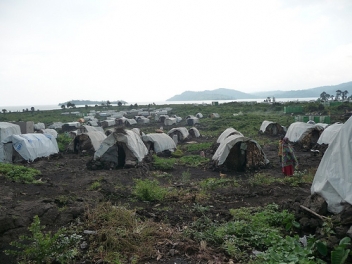 The day after my beautiful journey through Rwanda, I go to see three temprorary settlements of IDPs (internally displaced people) in Goma’s poorest bidon-ville (slum) where the city meets the Nyiragongo volcano.
The day after my beautiful journey through Rwanda, I go to see three temprorary settlements of IDPs (internally displaced people) in Goma’s poorest bidon-ville (slum) where the city meets the Nyiragongo volcano.
The area’s devastatingly eerie. You can see clearly two separate lava flows (1977 and 2002) which each destroyed everything and left nothing. Still people rebuild their ramshackle piles of wood and corrugated iron sheets in the black dust.
To create some sort of roads, or make way for whatever else, they’ve broken down the lava into manageable sharp angled stones piled up everywhere. Baffling. Never mind, the children still have their gorgeous, happy grins and shout ‘Muzungu’ (White) excitedly pointing at me. I want to squeeze them.
Travelling alone, for days
Because these are spontaneous settlement sites rather than official IDP camps, they do not qualify for UN food packages or non food items and the people there rely on the local community and rare hand outs from a few NGOs. I learn that many of the weakest are looked after by host families. People who are possibly just as poor as far as I can see.
Most people I meet tell me they abandoned their villages sometime last October when rebel fighting accross Kivu intensified. Most fled in a hurry with the clothes on their back. A few had time to organise rides out using market trucks or motorbikes. There, I meet grand-parents who have travelled alone, for days, with their grand children.
Begging to support her grandchildren
One woman explains that the parents were out in the fields when the rebels attacked. She had time to grab her grandchildren and flee. She has not seen or heard from the parents since. She begs for a living and sometimes does odd jobs on the local market such as laundry or washing up. She even sometimes carries heavy loads if her back pain allows.
They have lived like this for five months. The children don’t go to school and help by begging. One lady tells me she is worried they would become street children. By this she means that they will be influenced by older tougher children and learn begging and thieving as a way out of poverty.
“What I see everywhere is awful”
There are many sick people. A group of older people explain that they have to leave the church that shelters them during the day, every day to allow worship and stay outdoors until they are allowed back at night – It rains a lot in Goma so many have bronchitis. I could go on. What I see everywhere is awful.
I wonder why the displaced people in the temporary settlements haven’t joined the official IDPs camps where they would be accounted for and receive basic food rations and care. But there are all sorts of rumours circulating about the camps including bouts of violence and they are worried that they will be dispersed again.
To read more about HelpAge’s work in DR Congo.
